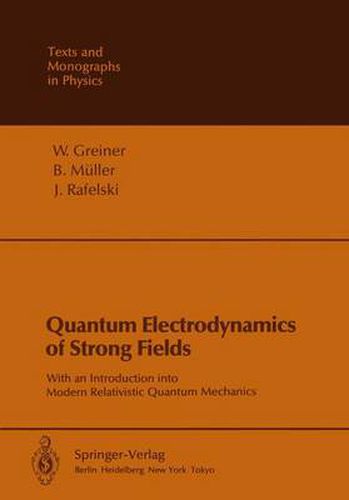Readings Newsletter
Become a Readings Member to make your shopping experience even easier.
Sign in or sign up for free!
You’re not far away from qualifying for FREE standard shipping within Australia
You’ve qualified for FREE standard shipping within Australia
The cart is loading…






This title is printed to order. This book may have been self-published. If so, we cannot guarantee the quality of the content. In the main most books will have gone through the editing process however some may not. We therefore suggest that you be aware of this before ordering this book. If in doubt check either the author or publisher’s details as we are unable to accept any returns unless they are faulty. Please contact us if you have any questions.
The fundamental goal of physics is an understanding of the forces of nature in their simplest and most general terms. Yet there is much more involved than just a basic set of equations which eventually has to be solved when applied to specific problems. We have learned in recent years that the structure of the ground state of field theories (with which we are generally concerned) plays an equally funda mental role as the equations of motion themselves. Heisenberg was probably the first to recognize that the ground state, the vacuum, could acquire certain prop erties (quantum numbers) when he devised a theory of ferromagnetism. Since then, many more such examples are known in solid state physics, e. g. supercon ductivity, superfluidity, in fact all problems concerned with phase transitions of many-body systems, which are often summarized under the name synergetics. Inspired by the experimental observation that also fundamental symmetries, such as parity or chiral symmetry, may be violated in nature, it has become wide ly accepted that the same field theory may be based on different vacua. Practical ly all these different field phases have the status of more or less hypothetical models, not (yet) directly accessible to experiments. There is one magnificent ex ception and this is the change of the ground state (vacuum) of the electron-posi tron field in superstrong electric fields.
$9.00 standard shipping within Australia
FREE standard shipping within Australia for orders over $100.00
Express & International shipping calculated at checkout
This title is printed to order. This book may have been self-published. If so, we cannot guarantee the quality of the content. In the main most books will have gone through the editing process however some may not. We therefore suggest that you be aware of this before ordering this book. If in doubt check either the author or publisher’s details as we are unable to accept any returns unless they are faulty. Please contact us if you have any questions.
The fundamental goal of physics is an understanding of the forces of nature in their simplest and most general terms. Yet there is much more involved than just a basic set of equations which eventually has to be solved when applied to specific problems. We have learned in recent years that the structure of the ground state of field theories (with which we are generally concerned) plays an equally funda mental role as the equations of motion themselves. Heisenberg was probably the first to recognize that the ground state, the vacuum, could acquire certain prop erties (quantum numbers) when he devised a theory of ferromagnetism. Since then, many more such examples are known in solid state physics, e. g. supercon ductivity, superfluidity, in fact all problems concerned with phase transitions of many-body systems, which are often summarized under the name synergetics. Inspired by the experimental observation that also fundamental symmetries, such as parity or chiral symmetry, may be violated in nature, it has become wide ly accepted that the same field theory may be based on different vacua. Practical ly all these different field phases have the status of more or less hypothetical models, not (yet) directly accessible to experiments. There is one magnificent ex ception and this is the change of the ground state (vacuum) of the electron-posi tron field in superstrong electric fields.